The next-gen MacBook Pro with Retina Display Review
by Anand Lal Shimpi on June 23, 2012 4:14 AM EST- Posted in
- Mac
- Apple
- MacBook Pro
- Laptops
- Notebooks
The King of All Notebook Displays
For years Apple has been shipping some of the best displays in consumer notebooks, but the MacBook Pro’s Retina Display is in a league of its own. While I never liked the phrase “painted on” in reference to the iPad and iPhone Retina Displays, that’s the best way I can describe the effect the MacBook Pro’s Retina Display has on me. Text really does look painted on. The effect is really the result of two things.
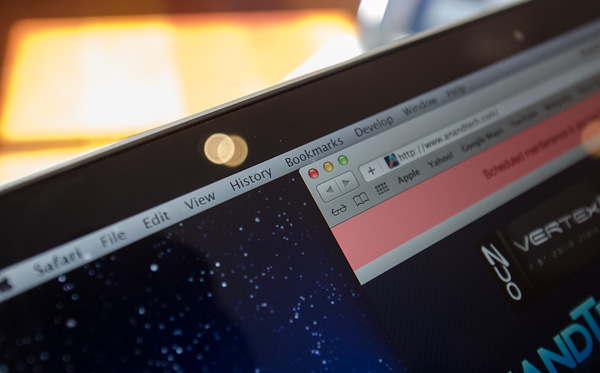
The first is Apple’s removal of its cover glass. LCD panels aren’t particularly attractive, they are ugly squares composed of two pieces of glass and a number of filters/polarizers. To hide the ugly edges, display makers wrap bezels around the display. Most people aren’t fond of bezels so next came a ton of effort to minimize bezel size. An alternative is to simply place a third piece of glass over the entire LCD assembly and make it look as if the bezel and LCD panel are integrated. This outermost layer is known as a cover glass and is what Apple uses on all of its glossy displays. If you’ve ever taken apart a Cinema/Thunderbolt Display or a newer iMac you’ll know that the cover glass is literally just a piece of glass that you have to remove with some suction cups.
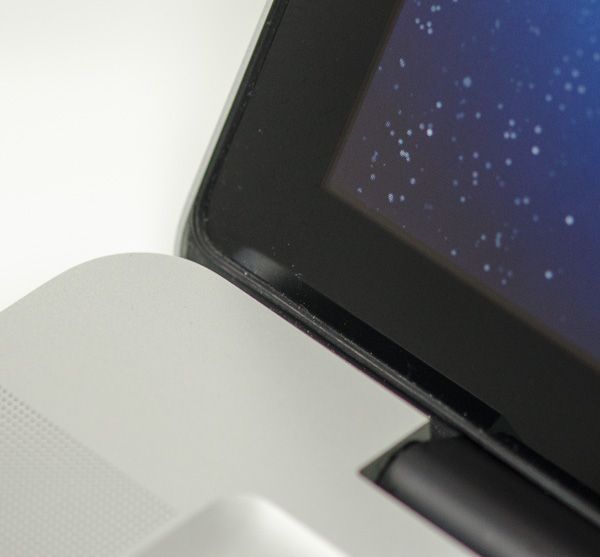
Non-Retina MacBook Pro, notice the gap between the outermost LCD glass and the cover glass
The MacBook Pro’s Retina Display does away with the cover glass and instead uses a fairly unique LCD assembly. There are still two pieces of glass but the outermost glass is actually a different size and shape - it integrates a bezel. By integrating the bezel into the outermost glass in the LCD stack you get the same effect as a cover glass but without the added reflections it introduces.
You also limit the possibility of dust getting trapped between the cover glass and the LCD. The danger is that you no longer have a protective piece of glass in front of your expensive new LCD. If you scratch the display you're scratching the LCD itself. While this has been true for conventional matte displays for a while, it's worth mentioning if you're used to Apple's glossy displays where you did have that added security layer.
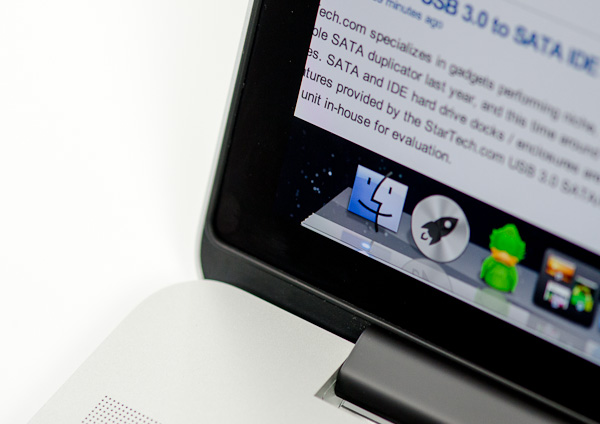
The MacBook Pro with Retina Display, no gap, no cover glass
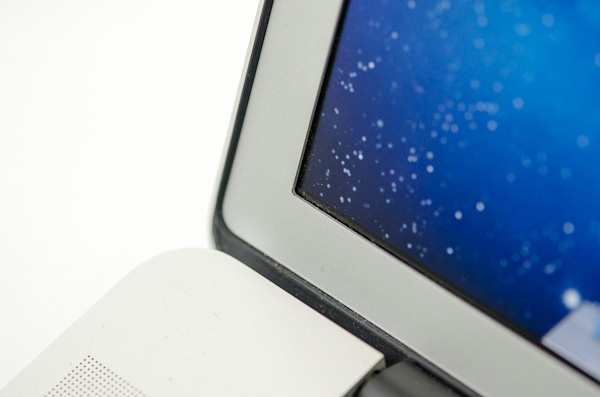
The 2011 MacBook Pro with High-Res Matte display option, no cover glass, top bezel

From left to right: 2010 High Res Glossy MBP, 2012 rMBP, 2011 High Res Matte MBP
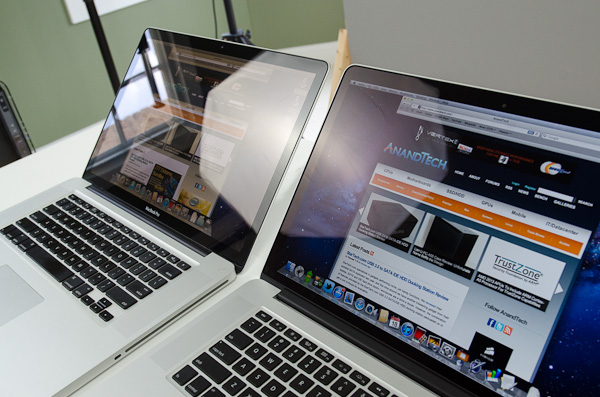
Glare handling indoors - 2011 High Res, Glossy MBP (left) vs 2012 rMBP (right)
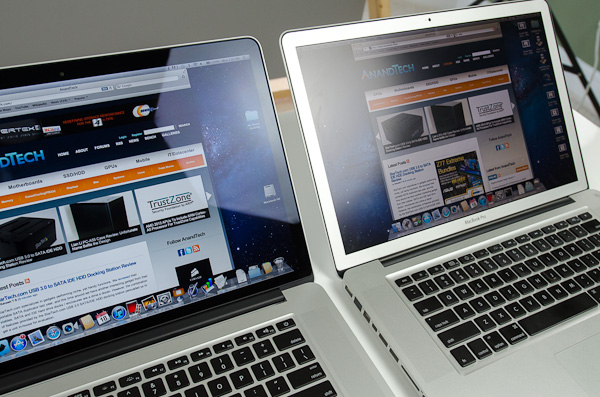
Glare handling indoors - 2012 rMBP (left) vs. 2011 High Res, Matte MBP (right)
The Retina Display is also obviously an extremely high resolution panel at 2880 x 1800. Note that this is 44.6% more pixels than Apple’s 27-inch Thunderbolt Display, and 26.6% more pixels than the 30-inch panels that we’ve loved for so long - all in a 15.4-inch notebook display.
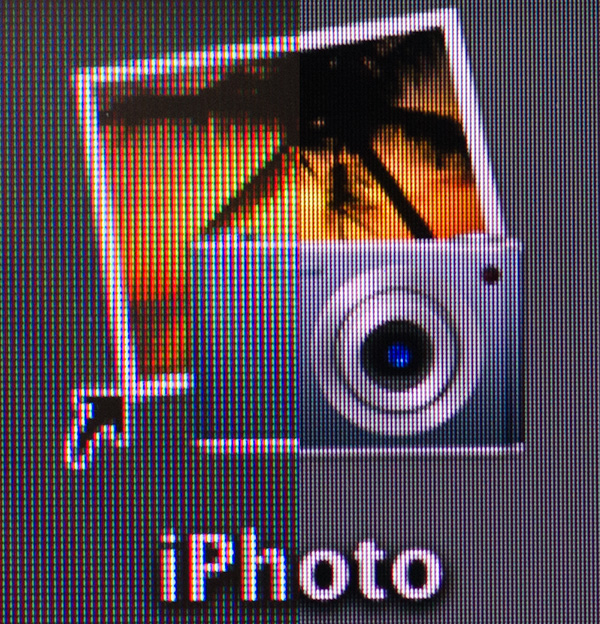
An iPhoto shortcut, High Res 2011 MBP (left) vs. Retina Display MBP (right)
At 220 pixels per inch it’s easily the highest density consumer notebook panel shipping today. At normal viewing distances and even with my face closer than I’m comfortable putting it I simply cannot discern individual pixels.
It’s the combination of these two elements, the removal of the cover glass and the insanely high pixel density that makes everything from text to UI elements just look painted on the new Retina Display. And the effect is gorgeous. I’ve never seen a prettier panel and it’s actually ruined me for pretty much all other displays, notebook and desktop.
While I can appreciate the iPad’s Retina Display, the impact from the MacBook Pro’s display is even more significant. Perhaps it’s because I still spend so much time working on a standard, non-tablet display, but I’m far more excited about this display than anything else Apple has delivered under the Retina moniker.
It’s not just pixel density that Apple has to offer here. Similar to its Retina Displays in the iPhone and iPad, the MacBook Pro’s Retina panel ditches TN in favor of IPS technology. The result is an incredible improvement in viewing angles. On a notebook I don’t spend a lot of time viewing it from far left/right angles, although I see the benefit when I’ve got others huddled around my display. Here the panel performs admirably - you lose brightness at far left/right angles but there’s no perceivable color shift. In fact, the painted on effect is even more impressive at these far left/right viewing angles.
For a single user however the more impressive characteristic is just how good the display looks at vertically off-center angles. I wrote much of the initial parts of this review while on an airplane in coach, which with a 15-inch notebook on my lap means I’m going to be looking at the display at a weird angle to begin with. The thinner rMBP doesn’t do enough to make the airplane usage model any better if the person in front of you decides to recline, but the IPS panel does make the display perfectly usable at the off-center angle you’ll inevitably have to deal with.
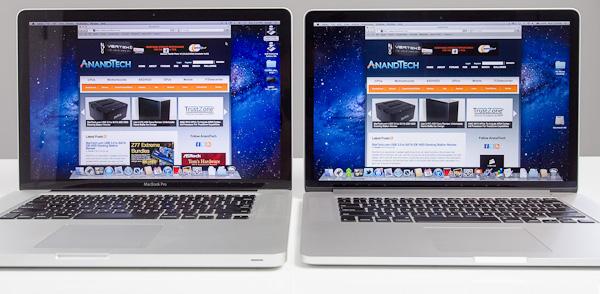
2010 High Res, Glossy MBP (left) vs. 2012 rMBP (right)
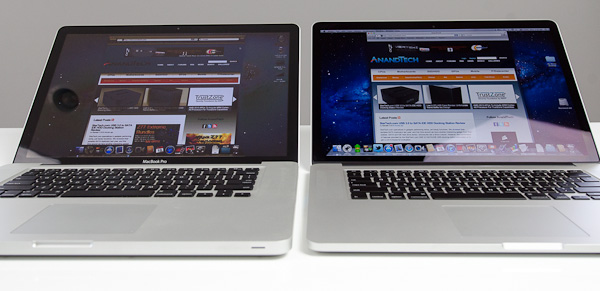
Hello colorshift!
2010 High Res, Glossy MBP (left) vs. 2012 rMBP (right)


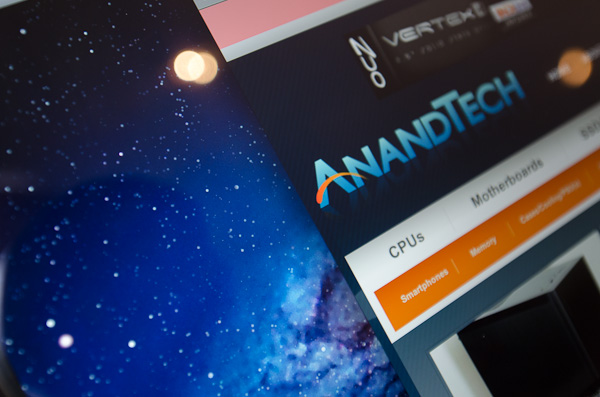
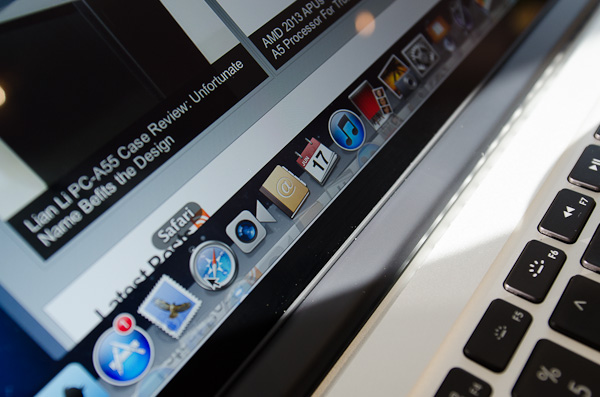
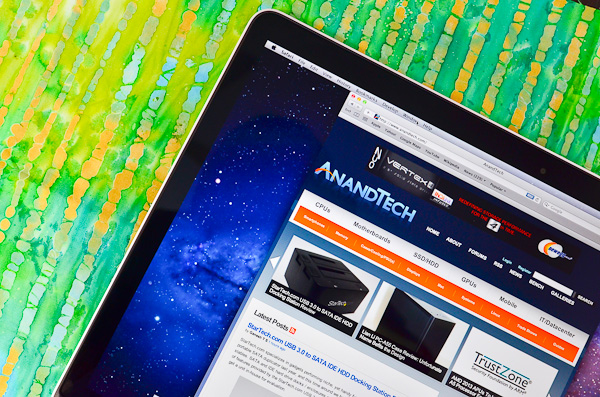
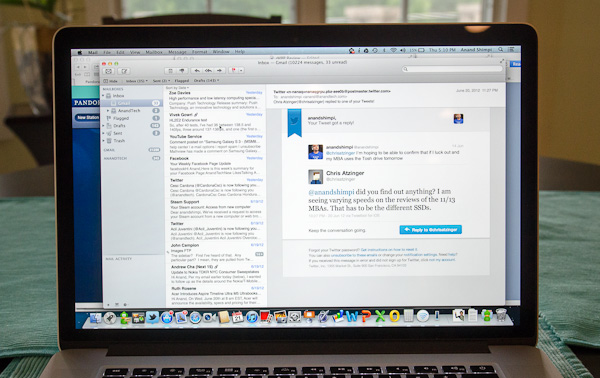
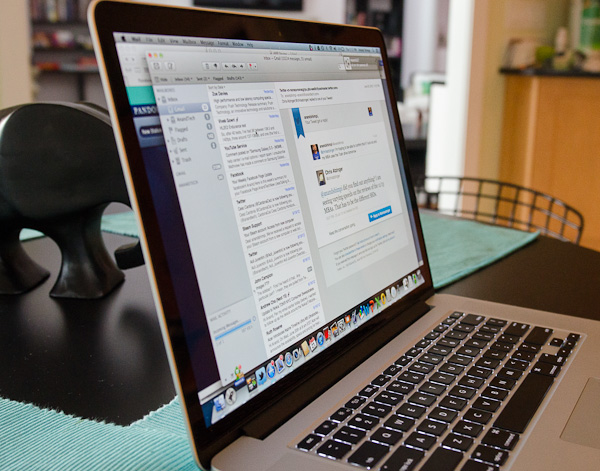








471 Comments
View All Comments
solipsism - Saturday, June 23, 2012 - link
it seems that any major changes to their Macs will come with Retina Displays. The question is when that will come because the iMac and ATDs are likely still to difficult to create and the smaller notebooks likely require more powerful GPUs.As Anand stated Intel is committed to more powerful iGPUs, which I'm fine with as my only concern is not seeing any visual lag and I don't play games, but I do think it's feasible for the 13" MBP to get a Retina Display once that ODD is removed. The only question I have is how much additional size is required to run an IPS display with 4x as many pixels. Can we assume the same battery capacity scaling between the 15" MBP and 15' RMBP?
ananduser - Saturday, June 23, 2012 - link
There is also a price concern. The retina panel on the 15"-er incurs a considerable increase. Lower retina screens on the lesser macbooks will incur themselves a price increase(lower but an increase nonetheless).KoolAidMan1 - Saturday, June 23, 2012 - link
The logic board on the 13" MBP is tiny, not enough room for a dedicated GPU. As it stands, Apple and other ultrabook manufacturers will be leaning on integrated graphics going forward. It is the only solution with chassis getting thinner and lighter. This is a big reason why Intel has been getting so much pressure to improve their IGPs, and Haswell is looking like a huge step in that direction.ananduser - Saturday, June 23, 2012 - link
Come on...Windows supports 200% DPI scaling. By default you have 125% and 150%, but if you go custom mode you can set the DPI slider way up to 200% and any value in between(not just 100% and 200%.OSX' pre-rendering hacks and workarounds do not mean resolution independence. They have achieved a similar result only for their specific configuration. Windows is closer to that ideal as from the start you have the choice to run the native resolution and all scaling can be realized in factors between 100%-200% within that resolution frame. From a software perspective it is more agnostic, therefore more elegant. You're too selfish in your Apple desires that you don't think about custom configurations and myriad of panel choices out there.
Super56K - Saturday, June 23, 2012 - link
I would never describe windows dpi scaling as elegant.Taft12 - Monday, June 25, 2012 - link
It's quite elegant. Windows software support for DPI scaling is not.Spoony - Saturday, June 23, 2012 - link
Quartz supports fully resolution agnostic layout, transforms, and compositing on a per-object basis. It also absolutely supports real resolution independence at any scaling value you desire. See this image from Mac OS 10.4:http://origin.arstechnica.com/images/tiger/scalabl...
Your move, smartypants.
ananduser - Saturday, June 23, 2012 - link
First of all Anand doesn't seem to know Windows well enough to go beyond presets.2nd of all, past OSX implementation of scaling was 2nd rate to that of Windows. OSX was unusable on high res screen without magnifying. I don't need to search for a longstanding macrumors post that described the frustrations of being a macuser on high res(and relatively small diagonal) past desktops.
3rd: internal rendering beyond the panel resolutions and then readjusting is anything but elegant. It is a specific workaround to a specific situation of a specific machine. Apple can't expect the entire world to rework everything to fit their quirky rendering.
Spoony - Saturday, June 23, 2012 - link
That's total garbage, and I suspect you know it.OS X has gone through various stages of teething with resolution independence. It was generally workable, but not always incredibly pretty. I remember U/I cracks and other uglies aplenty. However, setting to native res on a high-res panel and upscaling to 1.25x or 1.5x was very usable and very crisp, cracks aside.
Apple has always been interested in doing resolution independence right, from OS X's beginnings and using PDF as the specification template for their drawing layer. The fact of the matter is, Mountain Lion (and Lion for now) is executing a fully resolution independent desktop, and executing it very elegantly. Much more comprehensive and capable than Windows presently.
Furthermore, Apple has built up a very nice tool set of APIs that allow it (and third parties) to create a slick experience. For now, Windows can't touch it... however, I dearly hope Microsoft fixes this right up promptly. All OSs properly handling dense displays will be a great thing going forward.
ananduser - Saturday, June 23, 2012 - link
MS has nothing to fix as W8 is great from all standpoints. It is Anand's lack of knowing Windows settings that makes him state otherwise.Apple achieved a "resolution independence" type experience through presets. It only works with their available presets and makes use weird workarounds, while obfuscating panel res choices. If you apply a certain patch on OSX, unlock resolution choice and select the native res manually(or any other res) you'll see how resolution independent OSX is not.
You're naive if you think that all the possible past and current OSX 3rd party apps will do out-of-bound patches just to match, I repeat, a specific machine and it's specific pre-rendering routines.
Resolution independence in use is completely panel and resolution agnostic. No matter the native resolution of the panel you can scale the elements by any scale you wish. You do not need to pre-render, then cut the screen to fit your panel. Both os-es lack this effectively but OSX was traditionally worse than Windows.
Note: The true idealistic notion of resolution independece does not exist. Even ios is not resolution independent, it seems so because ios works only on two, integer scaled resolutions.